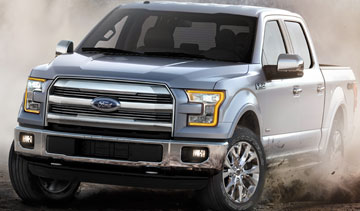
Ford gambles on aluminum F-150
by Dee-Ann Durbin, The Associated Press

Ford was scheduled to start production of the 2015 F-150 this week at its Dearborn Truck Plant

Ford is anticipating 13 weeks of down time at its two pickup truck plants in the U.S. to prepare for the launch of a new aluminum-clad F-150. PHOTO Ford
Ford was scheduled to start production of the 2015 F-150 this week at its Dearborn Truck Plant, four miles from the company’s headquarters. It will arrive at U.S. dealerships next month.
Ford thinks a truck that is lighter and more fuel efficient, but even more capable, will win buyers while its competitors struggle to catch up. Aluminum—which is lighter than steel but just as strong—isn’t new to the auto industry, but this is the first time it will cover the entire body of such a high-volume vehicle. Ford made 647,697 F-150 pickups at its two U.S. plants last year; that’s one every 49 seconds.
There are big risks. F-Series trucks have been the bestselling vehicles in the U.S. for 37 straight years; last year, Ford sold nearly 100,000 more full-size pickups than General Motors. Any quality problems, production hiccups or customer doubts about aluminum could slow sales and hurt Ford’s bottom line. Morgan Stanley estimates F-Series trucks account for 90 per cent of Ford’s global automotive profit.
CEO Mark Fields told the Associated Press he is confident Ford made the right decision. The new truck has been through 10 million miles of testing, which is more than any other vehicle in Ford’s history, he says.
Top managers agreed unanimously to switch to aluminum at a meeting in 2012.
“Were we recognizing that it was a risk? Sure,” Fields says. “But it was a very calculated and informed risk that gave us the confidence that we were going to get this done.”
If Ford’s bet pays off, it could gain an even more commanding lead in the lucrative truck market. More importantly, aluminum “future proofs” the truck in an era of rising fuel economy standards, says Karl Brauer, a senior analyst with Kelley Blue Book.
“If Ford masters the art of delivering an aluminum vehicle at the level the F-150 sells, they are going to be able to expand that to Mustangs, Edges and Lincolns,” Brauer says.
Truck buyers are among the most loyal in the auto market, and Ford can count on many of them. The company says more than 224,600 potential buyers have already asked for more details about the truck.
But even some Ford loyalists have their doubts. Ginny Pruet, who runs a wedding rental business in Rockwall, Texas, recently traded her 2012 F-150 for the 2014 version because she wanted a backup camera.
Pruet, 54, has checked out the 2015 version at auto shows. She is impressed by the new truck’s bells and whistles, like the movable LED spotlights on the side mirrors. But she’s concerned that aluminum is untested and not worth the extra cost. Ford has raised the price of the base model by $395 to $26,615, including destination fees. A fancier King Ranch version costs $3,615 more.
Ford’s promise of better fuel economy also failed to sway Pruet, who is paying less than $3 a gallon for gasoline in her area. Fuel economy numbers won’t be released until later this month, but Ford has said the 2015 truck will have up to 20 per cent better fuel economy than the outgoing model, which gets up to 23 mpg on the highway.
Ford has the disadvantage of introducing the truck as gas prices are hitting a four-year low. But Fields says even when gas prices were $1.25, truck buyers still asked for better fuel economy.
“These vehicles are not just vehicles to our customers. They’re tools to help them do their job,” Fields says. “This thing has to deliver.”
The F-150 sits on a high-strength steel frame that’s carrying less weight from the truck, so it can carry more cargo and haul heavier trailers. The new F-150 can tow up to 12,200 pounds compared with 12,000 for the Silverado and 10,500 for the Ram.
Ford is spending more than $1 billion to retrofit its plants in Dearborn and Claycomo, Missouri, where the trucks are assembled, as well as the metal stamping plants that make the parts, says Bruce Hettle, Ford’s vice-president of manufacturing, who spent three years planning the changeover.
Sparks used to fly from the noisy robots welding steel in the Dearborn body shop. Now, 500 new robots quietly rivet aluminum parts together. At Ford’s Buffalo, N.Y., stamping plant new machines collect and sort aluminum for recycling, which couldn’t be done with steel.
Ford also helped dealers with the $30,000 to $50,000 cost to retrofit their repair shops, says spokeswoman Elizabeth Weigandt.
Around 700 of the company’s 1,500 dealers who do collision repairs have gone through company training on aluminum, along with 700 independent repair shops. Weigandt says Ford took steps to minimize repair costs. Because of the way the aluminum is sectioned, for example, the roof doesn’t have to be removed to repair the B-pillar, which sits just behind the front doors.